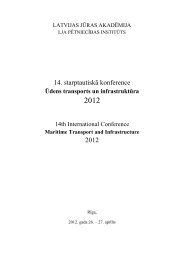Create successful ePaper yourself
Turn your PDF publications into a flip-book with our unique Google optimized e-Paper software.
their maritime education, takes decision to work on board (join the pool of active seafarers) or to leavepool without working on board as it can be seen in Figure 4.Figure 4. The model of graduates’ decision process (author)Illustrative concept of the model of graduates’ decision process shows average values of decisiontakers. Detailed assessment of education programmes and institutions is given in Table 2.Table 2. Contribution to outflow from maritime educational institutions (1995 - 2008)Final educational programme LMA* LMC* METTotal number ofpersons (100%)Share ofparticularprogrammeDeck officer 43% 57% 0% 1 990 28%Engine officer 29% 71% 0% 1 840 25%El. Engineer 15% 85% 0% 140 2%Deck officer < 500 GT 88% 6% 6% 280 4%Engine officer < 750 kW 51% 14% 35% 70 1%Deck rating 0% 38% 62% 1 730 24%Engine rating 0% 32% 68% 1 010 14%Deck/engine rating 0% 1% 99% 170 2%Total 23% 49% 27% 7 230 100%*including branches and programmes which are not active anymoreSource: author’s calculations based on data obtained from Seamen Registry of <strong>Latvian</strong> <strong>Maritime</strong> Administration53% of all graduates graduated from deck or engine officers programmes. Most of those graduatecome from Liepaja <strong>Maritime</strong> College (LMC). Approximately 35% of deck and engine ratings alsograduated from LMC however those programmes are not carried out in LMC anymore. Therefore thosedata reflect historical contribution of maritime educational institution which contributed to composition ofactive seafarers’ pool. Not all graduates from those programmes and institutions worked on board aftergraduation therefore the relative number of graduates who worked after completion the last educationalprogramme is showed in Table 3.Almost 80% percent of those graduates joined active seafarers’ pool. This parameter differscomparing various educational programmes and different maritime educational institutions. For example,the value for this parameter is higher if compare deck and engine officers graduating from LMC withLMA, but lower comparing graduates from LMC deck or engine rating programmes with graduatesgraduating from further vocational institutions.Figures given in Table 4 reflect the share of active graduates who joined active seafarers’ pool aftercompletion their last education programme (deck or engine officer) and are still active. If compare timeperiods it can be seen that main differences comparing educational institutions can be found in years 2005- 2008. The lowest value of this parameter is determined for graduates of LMA comparing with otherinstitutions in this time period. The data shows that relatively more graduates from Liepaja <strong>Maritime</strong>College are still active comparing with graduates from <strong>Latvian</strong> <strong>Maritime</strong> Academy and its’ branches.9
















